Report: The impact of climate change on UK properties and trade industries
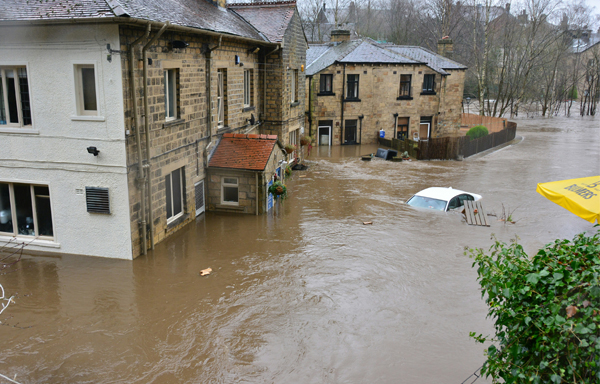
Climate Change Set to Drive £144M Worth of Annual Repair Work for UK Tradespeople by 2040, New Data Reveals
New analysis by Protrade reveals that escalating floods and heatwaves driven by climate change could push annual property repair costs in the UK’s 20 most populous cities to over £144 million, by 2040.
As extreme weather becomes increasingly common, climate-related risks are no longer a distant threat; they’re a growing reality for homeowners, and the tradespeople who maintain their properties. To explore the scale of this impact, Protrade analysed climate projections, housing data, and repair cost estimates across the country.
Drawing on UKCP18 data from the Met Office, the team calculated future levels of flood exposure and heatwave vulnerability by city. They then applied average repair costs for common climate-related damage – including subsidence, HVAC stress, damp, drainage, and structural fixes – to estimate the potential annual repair bill and identify which areas of property maintenance are likely to see the biggest rise in demand.
Key findings:
- Climate damage repair costs top £144 million annually in the UK’s 20 largest cities.
- London faces a £123m annual housing repair bill from flooding and heatwaves, with over 1 million at-risk properties.
- Birmingham (£5.9m), Bristol (£1.6m) Cardiff (£1.3m) and Coventry (£1.2m) follow in top 5 UK cities to face highest annual climate-related housing repair costs.
- London leads UK flood risk with 464,348 properties at risk, followed by Birmingham (45,203 homes) and Manchester (18,465 homes).
- Heatwave damage risk is highest in London (541,739 properties) and Birmingham (47,979 homes), with Midland’s cities also at risk.
- Construction expert on steps the UK must take to ensure the trades sector is equipped to tackle surging demand for property maintenance.
London faces £123m a year in climate-related property repairs by 2040
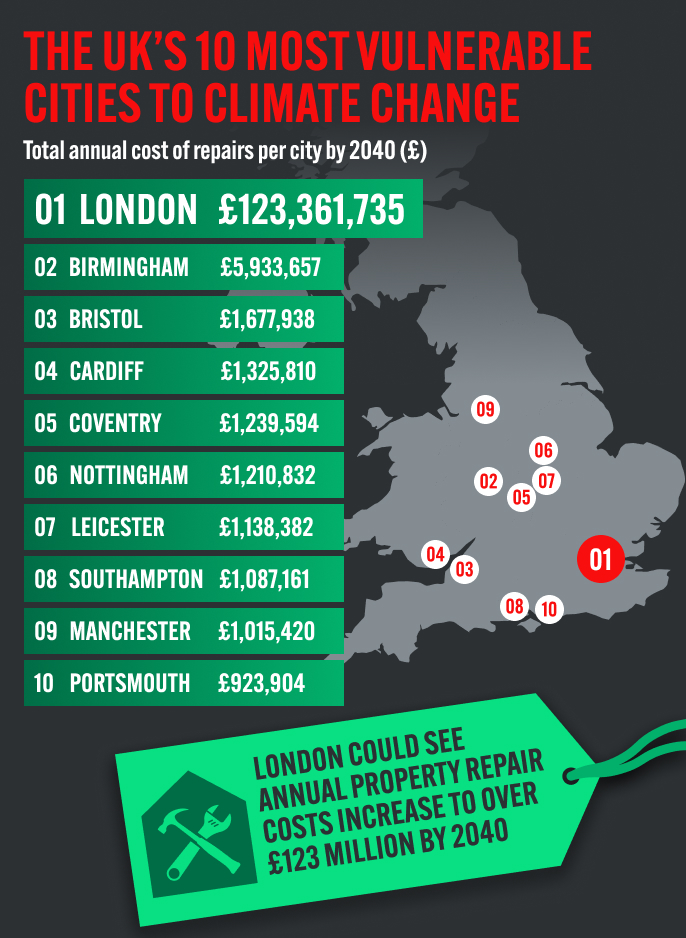
London ranks as the UK city most vulnerable to the impacts of climate change, with annual property repair costs estimated to reach £123.4 million by 2040. The capital has the highest number of properties at risk from both flooding (464,348) and heat-related damage (541,739).
Birmingham follows in second place, with annual repair costs estimated at £5.9 million. The city has 45,203 homes exposed to flooding and 47,979 at risk from heatwaves, meaning residents in affected properties could face an average of £64 in additional repairs each year.
Bristol’s £1.68 million in estimated annual repairs stems from its 12,670 flood-prone properties and 19,665 heatwave-exposed homes, leaving Bristolians facing at least £52 in average climate-related repairs. Cardiff, with 10,011 flood-vulnerable properties and 15,530 heat-sensitive homes, ranks fourth with £1.33 million in projected annual repair costs.
On these findings, Des Duddy, Joint Managing Director at Protrade, comments:
‘‘With projected repair costs across the 20 largest UK cities exceeding £144 million annually, this highlights the growing financial strain climate change could place on the housing sector if adaptive measures aren’t taken. As temperatures rise and extreme rainfall becomes more frequent, demand for both structural and surface-level repair is likely to surge – particularly in major urban centres like London and Birmingham.’’ Des Duddy, Joint Managing Director
London and Birmingham are most at risk of flood damage by 2040
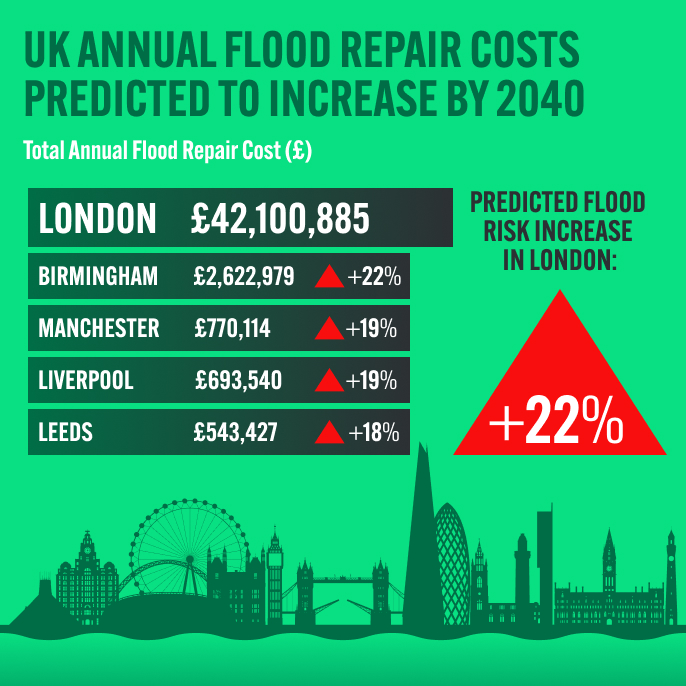
London stands out as the UK’s most flood-exposed city, with over 464,000 properties at risk; this could lead to a staggering £42.1 million in estimated annual flood-related repair costs. Birmingham ranks second, with 45,203 homes vulnerable to flooding and projected yearly damages of £2.6 million.
Manchester ranks third, with nearly 18,500 at-risk properties and estimated annual repairs of £770,114. Liverpool has 16,629 flood-prone homes, costing approximately £693,540 per year, while Leeds rounds out the top five with 21,406 properties at risk and annual repair needs totalling £543,427.
Southern and Midlands-based cities face mounting costs from heatwave-induced property damage by 2040
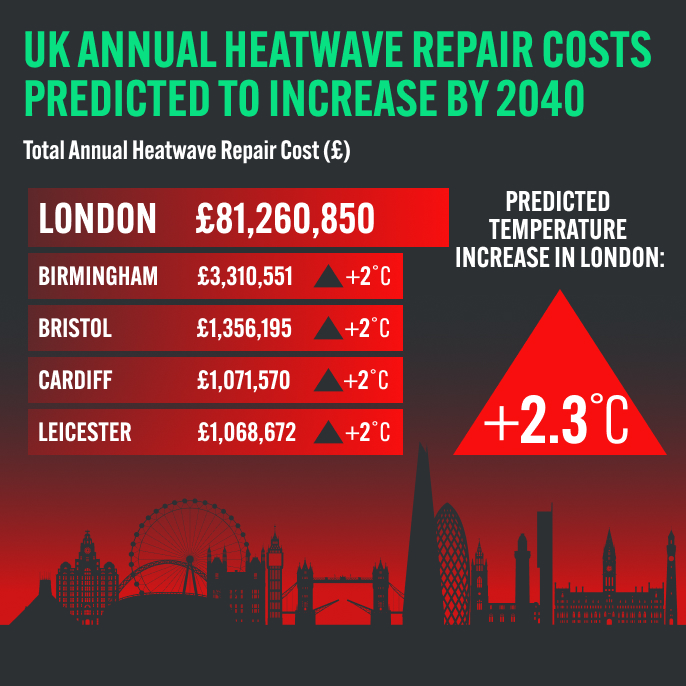
London again tops the list for heat-related risks, with 541,739 homes vulnerable and an annual repair burden of over £81 million. Birmingham faces £3.3 million in heatwave-related costs for nearly 48,000 affected homes.
Bristol follows with £1.36 million in costs for 19,655 properties, while Cardiff and Leicester both face around £1.07 million in annual repairs due to heatwave impacts on more than 15,000 homes each.
Heatwaves to drive surge in subsidence repairs and HVAC upgrades

Subsidence repairs are set to become the most expensive heat-related repair, with average costs reaching £15,000 per property. As temperatures continue to rise, more homes will also require HVAC installations/upgrades (costing £3,500) to keep indoor conditions safe during extreme heat.
Heatwaves will lead to roof and material degradation, with typical repair costs of around £2,500 and an increased demand for plasterers and tilers. On top of this, pipework and internal cracking, averaging £1,800 per incident, will increase with more frequent heatwaves caused by the expansion and contraction of materials in fluctuating heat.
Des comments, ‘As climate change progresses, we’re expecting a significant rise in demand for certain types of repair work by 2040. Subsidence repairs are likely to become more common as prolonged dry spells cause clay soils to shrink, threatening the structural stability of buildings. Add to that the projected increase in roof degradation, cracked materials, and internal damage from heat expansion, it’s clear the workload for tradespeople is set to grow massively over the next 15 years.’
Des comments, ‘As climate change progresses, we’re expecting a significant rise in demand for certain types of repair work by 2040. Subsidence repairs are likely to become more common as prolonged dry spells cause clay soils to shrink, threatening the structural stability of buildings. Add to that the projected increase in roof degradation, cracked materials, and internal damage from heat expansion, it’s clear the workload for tradespeople is set to grow massively over the next 15 years.’’
Wall and floor damage predicted to lead UK’s flood-related repair costs
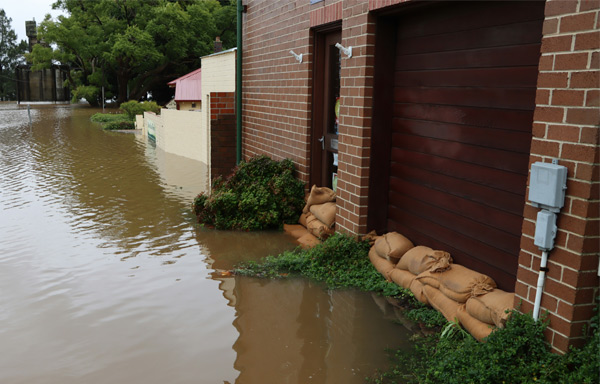
Flooding is expected to drive up a wide range of property repair costs by 2040, with wall and floor flood damage topping the list at an average of £7,000 per property. It will also result in more furniture and appliance losses, averaging £5,000 in repairs, particularly in ground-floor properties where water ingress can destroy electronics, soft furnishings, and white goods.
Other repairs that will see an increased demand include drying and clean-up jobs (£2,500), persistent damp and water ingress (£2,250), especially in older or poorly sealed homes, and gutter and drainage fixes (£1,000).
On the impact of flooding on UK homes, Des comments: ‘This increased risk of flooding means tradespeople can expect a surge in repair work involving flooring, plastering, insulation, and structural finishes. However, it’s important to note that these findings also underscore the importance of creating flood-resistant building designs to help minimise these costly, time-consuming repairs in the long run.’
Three important steps the UK must take to ensure the trades sector is equipped to tackle surging demand for property maintenance
As evidenced in this report, the worsening impacts of climate change – from more frequent flooding to increasingly intense heatwaves – are set to drive a sharp rise in property repairs across the UK.
With this in mind, Des Duddy, Joint Managing Director at Protrade, highlights three key steps the government and the construction and property maintenance sectors must take to help tradespeople prepare for the rising demand driven by these climate-related challenges.
1. Update training to focus on the skills and tools needed to spot and repair climate-related property damage
To scale climate adaptation within the building and maintenance sectors, the workforce needs to be ready. Engineers, builders, and tradespeople will play a key role in identifying and repairing climate-related damage – but they’ll need new tools and new training to do this effectively, including moisture sensors and thermal imaging to spot hidden damage.
It means understanding how to retrofit older homes for flood resilience, or how to address subsidence risk in areas with shrinking soils – especially on the clay-heavy soils common across southern England. To meet this challenge, apprenticeships and vocational training must evolve – embedding climate-specific repair skills as standard.
2. Incentivise specific skills training in locations where spikes in measures are expected
The UK government should incentivise skills training and support colleges regionally to ensure that towns and cities have access to a locally skilled-up workforce that can meet spikes in demand for specific climate-related property damage.For example, colleges in Reading and Bristol must be supported to meet a rising demand for workers that can repair electric fittings and pipework during a heatwave, whilst education providers in Liverpool and Southampton must be empowered to upskill local workers in how to tackle damp and wall damage in the event of increased flooding.Doing so will in turn make it easier for homeowners to find locally trusted contractors to deliver emergency work in the event of damage to their home.
3 .Incorporate climate adaptation into building standards
Climate resilience won’t happen without clear direction from the government. Builders can’t design for risks they’re not asked to consider, and households will struggle to absorb the cost of retrofitting their property alone.
Meanwhile, UK building regulations still do not reflect the climate risks we face. The upcoming Future Homes Standard will make new homes “zero-carbon ready”, but little ambition has been shown so far about protecting those homes from flooding or extreme heat.
That has to change. Climate resilience must be written into building standards, with mandatory risk assessments at the planning and design stage, not bolted on after the fact. Failure to do so will mean that the government’s current plans to boost new-build homes will inadvertently create more properties that will be vulnerable to climate-related risks.
Methodology
To assess the financial impact of climate-related damage to UK housing, we used a multi-step methodology combining climate projections, property data, and repair cost estimates.
First, we drew on UK Climate Protections 18 data from the Met Office to estimate the percentage increase in flood risk by 2040 for the UK’s top 20 most populous cities. We then created a flood risk index, scaling from London’s projected 14% exposure (the highest) down to cities with lower risk levels, this was repeated for heatwaves. Next, we calculated the number of properties in each city likely to be affected by flooding or heatwaves. This was done by applying each city’s share of heatwave and flooding vulnerability to the total number of households in that city.
To estimate repair costs, we identified five common types of heatwave-related damage, such as subsidence, HVAC upgrades, roof/material stress, pipework cracking, and electrical faults – and calculated an average repair cost per household using average costings from CheckaTrade cost guides. These figures were then multiplied by the number of heatwave-affected properties in each city to provide estimates of repair costs per city. To provide estimated average costs. For flooding, the five common types of damage used to calculate repair costs were furniture and appliances repairs, drying and clean-up, damp and water ingress, gutter and drainage fixes, and wall and floor repairs. Average repair costs were sourced from the CheckaTrade cost guides and HomeServe, with figures then multiplied by the number of flood-vulnerable properties in each city.
Finally, to arrive at an annualised cost, we assumed that major heatwave-related repairs occur roughly once every 10 years and divided the cumulative repair costs accordingly. This provides a city-by-city estimate of the annual financial burden expected from increased climate-related housing damage by 2040.
Image: Chris Gallagher on Unsplash

Joint Managing Director, Protrade
Des has over 30 years of experience at Protrade, having worked in the capacity of Sales Co-ordinator, Account Manager, and product development, culminating in being appointed Joint Managing Director in 2018.



